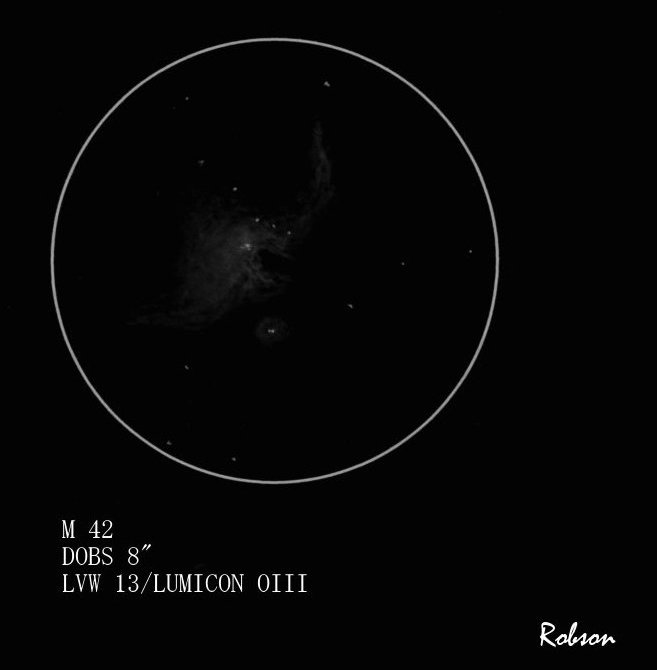
Messier 42
Sketch and Details by Robert Gudański
M42
Newton 8″
LVW 13
Lumicon OIII
22.01.2010
Stepnica, Poland
Robert Gudański
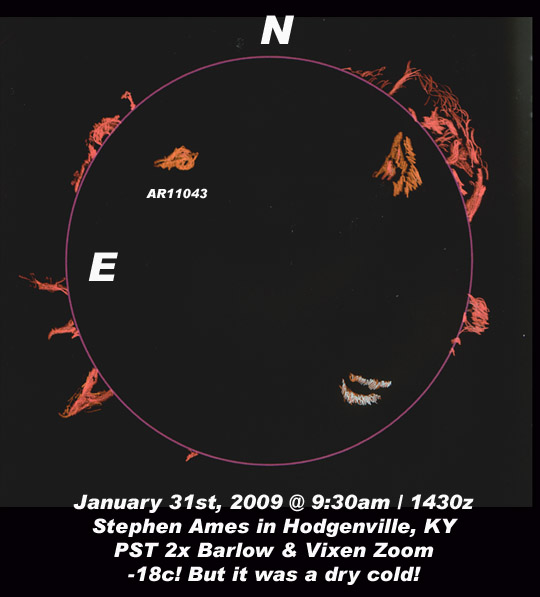
Sun – January 31, 2010
Sketch and Details by Stephen Ames
I use:
Crayola Cerulean pencil for plage
Crayola Aqua Green pencil for proms
White 20# paper
I scan into photoshop and invert.
Blue skies,
Stephen Ames
Hodgenville, KY
See your life giving sun in vivid images and art
from observers all over the world at
www.SeeMySunspot.com
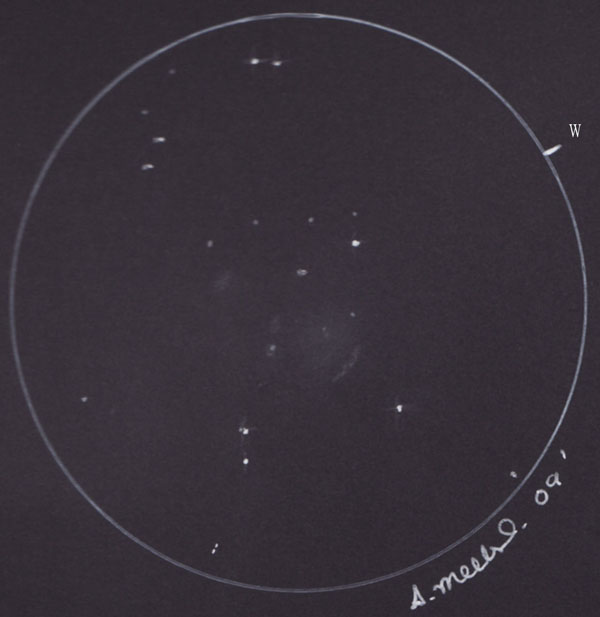
ESO 350-40
Hover mouse over image to view labels
Sketch and Details by Scott Mellish
ESO 350-40
The “Cartwheel Galaxy”
Ring Galaxy
Ilford NSW Australia
13/12/09
56cm f5 Dobsonian telescope
Field: 27′
218x magnification
Sky Quality Meter reading 21:76
Black Canford paper
White oil pencil
White pen
White pastel chalk
The enigmatic Cartwheel Galaxy is a tough enough object to observe let alone sketch.
During a nice clear night in December I made an attempt to sketch it as accurately as possible to the actual eyepiece view, and I was reasonably pleased with the end result.
The trouble with the Cartwheel is that it is quite faint and ill defined in most amateur telescopes, as averted vision is required to capture glimpses of the more subtle features of the object.
To sum up the galaxy is visible as a soft oval glow some 2.0′ x 2.0′ in size, with the two unusual companion galaxies around 1.3′ to the left as can be seen in the sketch.
Another galaxy some 2.0′ above and slightly to the left of the companions was also visible, this galaxy has no relationship with the Cartwheel.
Sculptor was getting a bit low in the west whilst I was doing this sketch, but it was possible during moments of steady seeing and using averted vision to just barely make out the ring structure, but it was very faint.
I could not detect any hint of the “spokes” as seen in the Hubble image, but with a larger scope and steadier seeing they could quite possibly be a chance.
The brighter more active star forming region of the galaxy was discernible as a slightly mottled curved patch some 1.6′ x 0.4′ in size, as can be seen slightly off center to the lower right.
I have included a duplicate reference sketch for those unfamiliar with this elusive and very rare object.
Scott Mellish

NGC 7582, NGC 7590 and NGC 7599
Sketch and Details by Serge Vieillard
During his stay at LaPalma in October of 2009 Serge began one of his nights examining galaxies in the constellation of Grus, the southern crane using the 16″ telescope (T400-c). This constellation is packed with galaxies including this group of three in one field of view: NGC 7582, NGC 7590 and NGC 7599. A fourth member of this group of spiral galaxies (NGC 7552) is outside the eyepiece field of view and therefore is not included in this sketch. All four of these interacting galaxies are known as the Grus Quartet.
Object: NGC 7582, NGC 7590 and NGC7599 – Artist: Serge Vieillard – Sketch Date: October 2009 – Sketch Location: La Palma in the Canary Islands
Translation by Frank McCabe
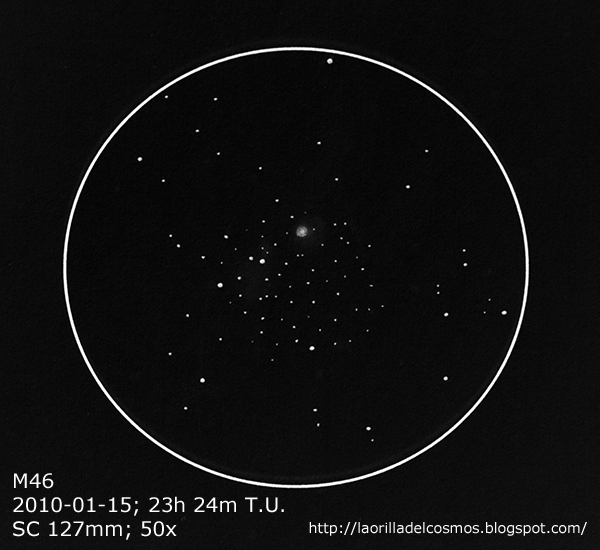
Messier 46 and NGC 2438
Sketch and Details by Oscar Ll. (Almach)
Object Type: Open Cluster – Planetary Nebula
Location: Barcelona – Spain
M46 is one of my favorites open cluster. But is necessary dark skies without light pollution in order to enjoy with its view.
This open cluster practically fills the eyepiece field with 50x. We can see a large number of stars not too bright, between 9th and 14th magnitude… and the surprise: the planetary nebula NGC2438. To see the planetary I had to use an OIII filter.
For more details of my observation you can visit my blog:
http://laorilladelcosmos.blogspot.com/2010/01/m46-cumulo-abierto-con-sorpresa-en.html
M46 – Open Cluster / NGC 2438 Planetary Nebula
Date and Time: 2010-01-15, 23h 24m UT
Telescope: SC Celestron Nexstar 5i (5″)
Eyepiece: 25mm (50x)
White paper, HB2 graphite pencil, and scanned and inverted with Photoshop
Seeing: 4/5 (5 the best)
Transparency: Clear. Moderate light pollution.
Location Constellation: Puppis
Position: R.A. 07 h 42 min
Dec. -14° 49′
Thank you and best regards.
Oscar
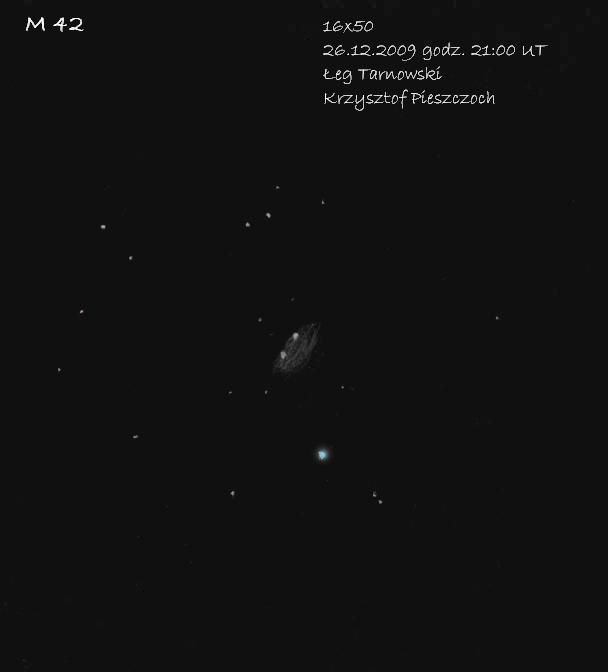
Messier 42
Krzysztof Pieszczoch (Astrokrzychu)
Hi,
It is a Christmas M 42 🙂
This sketch shows how M 42 look likes through 2” binocular. When I was sketching this nebula I had low moonlight on the sky, because the Moon was two day past first quarter. From this reason I didn’t caught more details in M 42.
Object name: M 42 (Messier 42)
Object type: Nebula
Location: Łęg Tarnowski , Poland
Date: 26 December 2009 r.
Time: 21:00 UT
Artist: Krzysztof Pieszczoch (Astrokrzychu)
Equipment used: Binocular 16X50 (2″) FOV 4,25 deg.
weather conditions:
– Temperature about 0 Celsius degrees.
Yours sincerely,
Krzysztof Pieszczoch
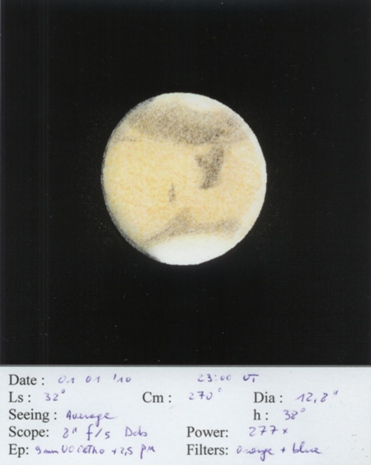
Mars – January 1, 2010
Sketch and Details by Kris Smet
Only average seeing last night, but a few good moments allowed to make a quick sketch!
Syrtis Major looked interesting, the light dessert seemed to run into Syrtis Major just above Moeris Lacus (?) the tip ended with a curved hook to the left. Hellas was the second brightest feature after the polar ice. seeing wasn’t stable enough to see any clouds over Lybia or Aeria though (left and right of Syrtis Major).
The dark plains Utopia and Boreo Syrtis above the NPC. Nodus Alcyonius was also visible at momenst of good seeing, Aetheria wasn’t however.
A lighter region, the division between Mare Cimmerium & Mare Tyrrhenum was quite easy to spot.
I chose to use the 8″ with the fan running during the sketch and an hour before because temperatures dropped to (i guess) 4 or 5°C minus.
Mars is big enough now to allow some great views if seeing cooperates!
01/01/10
location: bornem, belgium

NGC 2516
Sketch and Details by Orestis
The Open Cluster: NGC 2516
As soon as i laid my eyes on this beautifull cluster i knew that i must sketch it and so i did.
Observation and sketch was made at my home in Australia.
It was a beautifull clear sky but there was a near full moon so i decided to try and sketch something bright and the first object which came to mind was ngc 2516 which i could still see naked eye despite the near full moon.
I observed for a while and then started sketching ,i had never sketched a open cluster before and i didn’t know it was going to be so fun.I counted about 80 or so stars in the fov and noticed that the distibution of the stars was quite irregular were they seemed to loop out from the red central star.There was also a bright yellow star to the far east.
Sketch info:I used a 130mm reflector and a 20mm plossoll as my observing tools.I used a #2 mechanical pecil to plot the stars on 110 gsm white paper and then digitized it using gimp.All in all the sketch took about an hour to complete at the eyepiece.
To me ngc 2516 is like a blossoming flower waiting to be gazed upon,it truelly is an amazing open cluster.
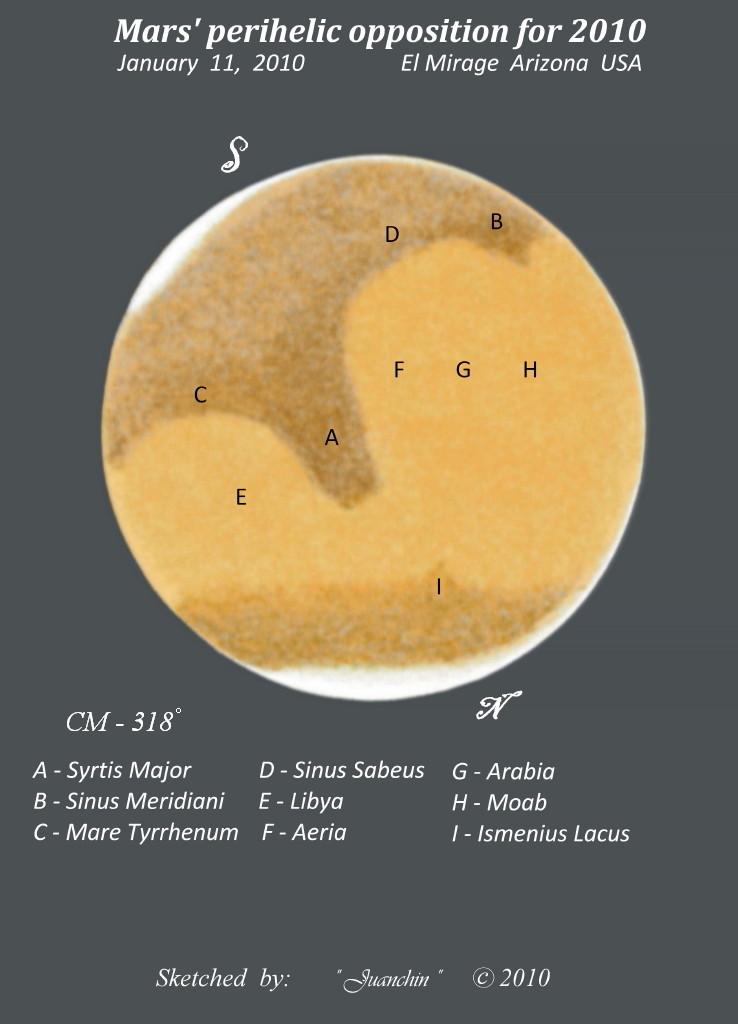
Mars – January 11, 2010
Sketch and Details by Juan Perez (Juanchin)
Object : Planet Mars
Date : January 11, 2010
Time : 23:30 LST / 06:30 UT
Location : El Mirage Arizona USA
Instrument : CPC 1100 / 10 & 7mm Plossl’s
Magnitude : -.7 (Stellarium)
Weather : Chilly night but pleasant, upper 40’s, clear sky!
Mars is an eyecatcher for several reasons; Mars is simply at that time of its orbital cycle where it is closest to Earth and also closest
to the Sun – perihelion. Earth’s position is in the middle thus we say that Mars is at opposition. These two opportunities are not to be
missed, for Mars increases in disc size and becomes brighter by having fuller illumination of its surface by the Sun. For those of us in
the Northern hemisphere, how could you not resist pointing your telescope directly above your head and focus on the orange glowing
planet.
At 13.6 arc-seconds it doesn’t rival its disc size like that of 2003 when it increased to almost twice its size, 25 arc-seconds in
diameter.Even though I lack the eagle vision that a few of you ASOD regulars posses, I was still able to distinguish just a few albedo
features. The South and North polar caps were highly pronounced along with a stretch of bright limb haze around the edge of the disc.
The dark collar which follows the NPC was visible although it varied in its intensity, guessing from turbulence in the Earth’s atmosphere.
The most striking and noticeable dark region was that of Syrtis Major.I spent a few hours trying to work my eyesight in search of any
other subtle details which I ended alphabetizing on the sketch.
Again, Mars is at the center of attention this month and it beckons us to explore its surface details with those optical instruments.
Give it a try, for Mars is looking up! 😀